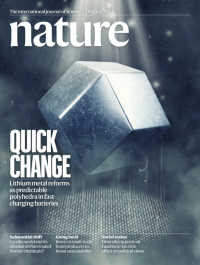Volume 620
-
No. 7976 31 August 2023
Drone racer: AI pilot beats human champions in aerial contestArtificial intelligence has taken on and beaten human competitors in many games, including chess, StarCraft and Gran Turismo. But such successes have largely been limited to board games or virtual worlds. In this week’s issue, researchers from the University of Zurich present an autonomous system that can compete in the physical world of drone racing. Professional-level drone races involve piloting aircraft around a complex 3D circuit, which presents a significant challenge to a robot because it has to fly fast while estimating speed and location using onboard sensors. The researchers combined deep reinforcement learning with data from the physical world to create their autonomous drone, which they named Swift. In competition against human pilots, including world champions, Swift won 15 out of 25 races and recorded the fastest race time.
Focal Point
-
No. 7975 24 August 2023
Tropical gainsProtected areas, such as national parks and nature reserves, form part of a strategy to preserve biodiversity, but how effective they are within and outside their boundaries is not always clear. In this week’s issue, Jedediah Brodie and his colleagues examine protected areas in mega-diverse southeast Asia to assess their effects on tropical biodiversity. By accounting for site accessibility and the 3D structure of forests, the researchers were able to determine that reserves increased the diversity of birds and mammals, such as the northern pygmy loris (Xanthonycticebus intermedius) pictured on the cover, both inside their boundaries and in the surrounding landscape.
-
No. 7974 17 August 2023
Beak and clawsThe cover shows an artist’s impression of Venetoraptor gassenae, a species of ancient reptile that lived some 230 million years ago. Dinosaurs and pterosaurs dominated land and air, respectively, around 70 million to 200 million years ago, but their evolutionary precursors are not that well known. Venetoraptor is a member of a family of reptiles called lagerpetids, which are the closest known non-flying group to pterosaurs. Found in Brazil, the well-preserved partial skeleton of Venetoraptor is described in this week’s issue by Rodrigo Müller and his colleagues. The fossil has unusual features, including a toothless beak and enlarged hands with scimitar-like claws. The researchers note morphological differences between Venetoraptor and other precursor remains, which suggests that diversity was starting to flourish among the precursors and wasn’t something that emerged solely with the arrival of dinosaurs and pterosaurs.
-
No. 7973 10 August 2023
About the coverCar wheels and billiard balls follow a linear path when they roll down a flat slope. More exotically shaped solids, such as oloids, trace a sinusoid-like route. In this week’s issue, Bartosz Grzybowski and his colleagues take a more generalized approach to rolling objects, creating an algorithm to design a shape that will follow a predefined periodic path when rolling down a slope. They then printed these ‘trajectoids’ in 3D, as pictured on the cover, to test if they worked. The team found that the bodies followed the predicted pathways, sometimes even those that took the object intermittently uphill.
Nature Index
-
No. 7972 3 August 2023
Quick changeLithium-metal batteries promise to charge rapidly and to hold more energy than batteries based on lithium ions. Recharging these batteries requires lithium metal to be reformed at the anode, but this process is affected by the battery’s electrolyte and current collector, which causes the shape of the lithium deposits to vary unpredictably, impairing the battery’s performance. In this week’s issue, Yuzhang Li and his colleagues probe the factors that influence lithium-metal deposition and reveal a way to achieve consistent, predictable results. Using cryogenic electron microscopy, the researchers found that lithium intrinsically forms perfect 12-face polyhedra, as pictured on the cover. The team discovered that by depositing the lithium fast enough, it will also form these rhombic dodecahedra in four different electrolytes and four different current collectors, upending conventional wisdom on lithium electrodeposition and paving the way for potential improvements to lithium-metal batteries.
Focal Point





